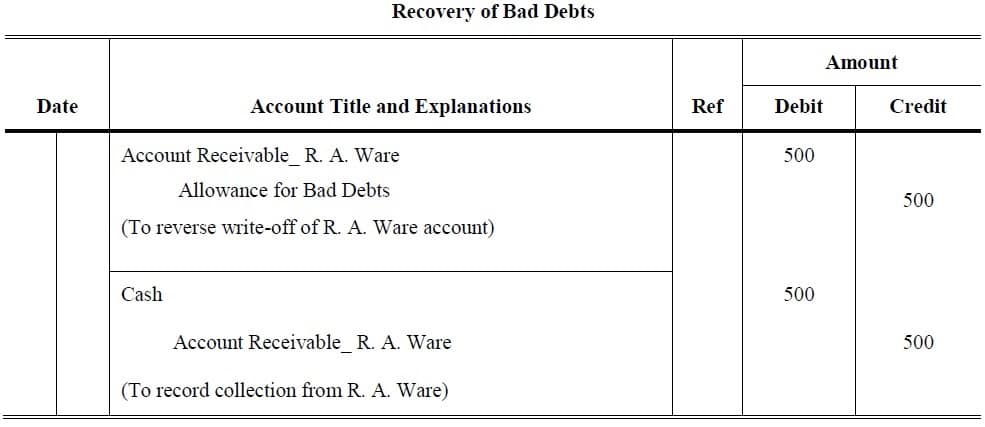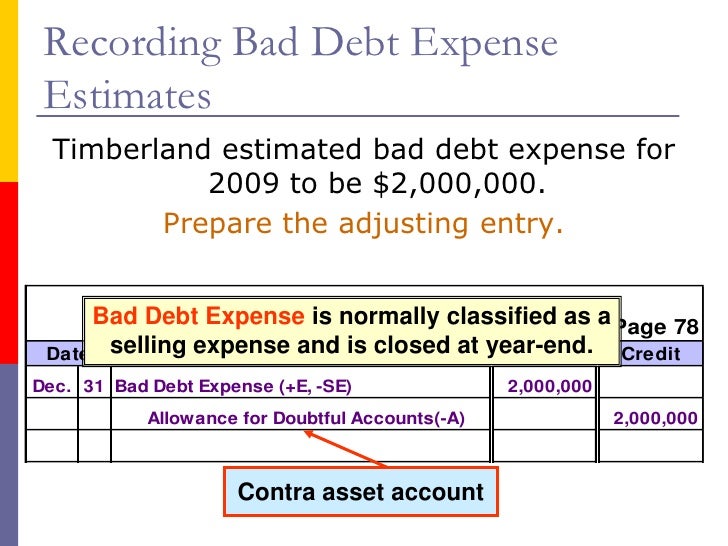-Hallo friends, Accounting Methods, in the article you read this time with the title Under The Allowance Method Bad Debts Expense Is Debited When, we have prepared this article well for you to read and retrieve the information therein.
Hopefully the content of article posts Allowance, article posts Debited, article posts Debts, article posts Expense, article posts Method, article posts Under, article posts Under The Allowance Method Bad Debts Expense Is Debited When, article posts When, which we write this you can understand. Alright, happy reading.
Title : Under The Allowance Method Bad Debts Expense Is Debited When
link : Under The Allowance Method Bad Debts Expense Is Debited When
Under The Allowance Method Bad Debts Expense Is Debited When
Chapter 8 Exerciseacc 556 Flashcards Quizlet
Allowance Method I Bad Debts I Accountancy Knowledge
Underthe allowancemethod of calculating bad debts, there are two general ledger accounts bad debts, an expense account, and allowance for doubtful accounts, a contra-asset account used to offset to the accounts receivable balance. to record the bad debt expenses, you must debit bad debt expense and a credit allowance for doubtful accounts. The doubtful account in balance, which records when they estimate the bad debt. how to calculate bad debt expense. as we have mentioned above, company has two options when recording bad debt expense, which is the direct write-off and allowance method. direct write off. the company does not require to estimate the percentage of the uncollectible. Under the allowance method, if a specific customer's accounts receivable is identified as uncollectible, it is written off by removing the amount from accounts receivable. the entry to write off a bad account affects only balance sheet accounts: a debit to allowance for doubtful accounts and a credit to accounts receivable. no expense or loss is reported on the income statement because this write-off is \\"covered\\" under the earlier adjusting entries for estimated bad debts expense. Question: print item under the direct write-off method of accounting for uncollectible accounts, bad debts expense is debited a. when an account is determined to be worthless b. at the end of each accounting period c. whenever a predetermined amount of credit sales have been made d.
Underthe allowancemethod, baddebtexpenseis debited when an account is deemed uncollectible and must be written off. May 14, 2009 · 5. under the allowance method, bad debts expense is debited when an account is deemed uncollectible and must be written off. 6. an aging schedule is prepared only for old accounts receivable that have been past due for more than one year. 7. an aging schedule is required when bad debt expense is based on a percentage of the company’s net.
Accounting chapter 8 wiley questions flashcards quizlet.
Test Docx Under The Allowance Method Bad Debt Expense Is

Underthe allowancemethod, baddebtexpense is recorded a) when an individual account is written off. b) when the loss amount is known. c) for an amount that the company estimates it will not collect. d) several times during the accounting period. The account allowance for doubtful account is credited when the account bad debts expense is debited under the allowance method. the use of allowance for doubtful accounts allows us to see in accounts receivable the total amount that the company has a right to collect from its credit customers.
Chapter 8 Exerciseacc 556 Flashcards Quizlet
In this example, estimated bad debts are $5,000. if the account has an existing credit balance of $400, the adjusting entry includes a $4,600 debit to bad debts expense and a $4,600 credit to allowance for bad debts. percentage of credit sales method. some companies estimate bad debts as a percentage of credit sales. For this reason, bad debt expense is calculated using the allowance method, which provides an estimated dollar amount of uncollectible accounts in the same period in which the revenue is earned. At the end of year 2, the company’s actual bad debt was $5000. suggest the accounting treatment to be done if the company follows the allowance method of recording bad debt expenses. solution. first of all, we will calculate the bad debt expense under the allowance method bad debts expense is debited when to be recognized in year 1 & 2. calculation of bad debt expense =145000*2%; bad debt expense will.
The allowance method of accounting for bad debts involves estimating uncollectible accounts at the end of each period. it provides better matching of expenses and revenues on the income statement and ensures that receivables are stated at their cash (net) realizable value on the balance sheet. The allowancemethod usually refers to one of the two ways for reporting bad debts expense that results from a company selling goods or services on credit. (the other way is the direct write-off method. ) under the allowance method bad debts expense is debited when under the allowance method, a company records an adjusting entry at the end of each accounting period for the amount of the losses it. 5. under the allowance method, bad debts expense is debited when an account is deemed uncollectible and must be written off. 6. an aging schedule is prepared only for old accounts receivable that have been past due for more than one year. 7. an aging schedule is required when bad debt expense is based on a percentage of the company’s net.
Allowance Method I Bad Debts I Accountancy Knowledge


Under the allowance method, bad debt expense is recorded a) when an individual account under the allowance method bad debts expense is debited when is written off. b) when the loss amount is known. c) for an amount that the company estimates it will not collect. d) several times during the accounting period. Another way sellers apply the allowance method of recording bad debts expense is by using the percentage of credit sales approach. this approach automatically expenses a percentage of its credit sales based on past history. See full list on accountingcoach. com. Under the allowance method, bad debt expense is recorded a) when an individual account is written off. b) when the loss amount is known. c) for an amount that the company estimates it will not collect. d) several times during the accounting period.
Sep 26, 2020 · for this reason, bad debt expense is calculated using the allowance method, which provides an estimated dollar amount of uncollectible accounts in the same period in which under the allowance method bad debts expense is debited when the revenue is earned. To record bad debt expense using the allowance method, the adjusting entry would be a a. debit to bad debt expense and a credit to allowance for doubtful accounts. b. debit to accounts receivable and a credit to allowance for doubtful accounts. c. debit to loss on credit sales and a credit to accounts receivable. d. Under the allowance method, bad debt expense is debited when an account is deemed uncollectible and must be written off. The bad debts expense remains at $10,000; it is not directly affected by the journal entry write-off. the bad debts expense recorded on june 30 and july 31 had anticipated a credit loss such as this. it would be double counting for gem to record both an anticipated estimate of a credit loss and the actual credit loss.